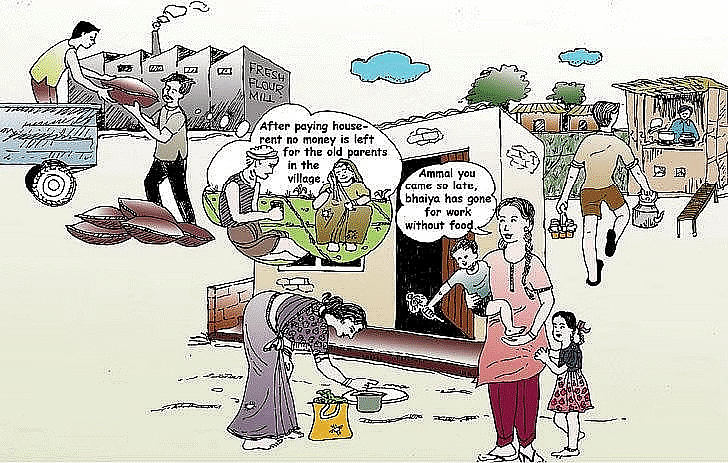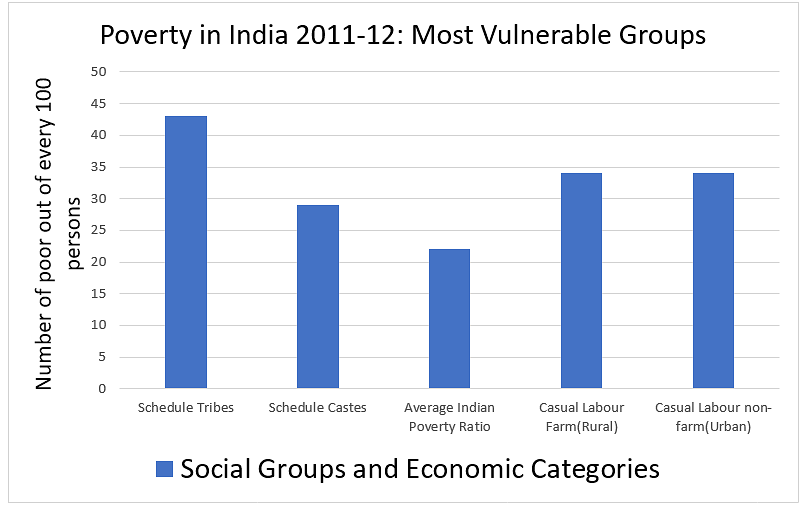Class 9 Economics Chapter 3 Notes - Poverty as a Challenge
Introduction
In independent India, poverty is a significant challenge and many people lack the money and resources for a decent life. Examples include landless laborers, crowded urban slums, and child workers. 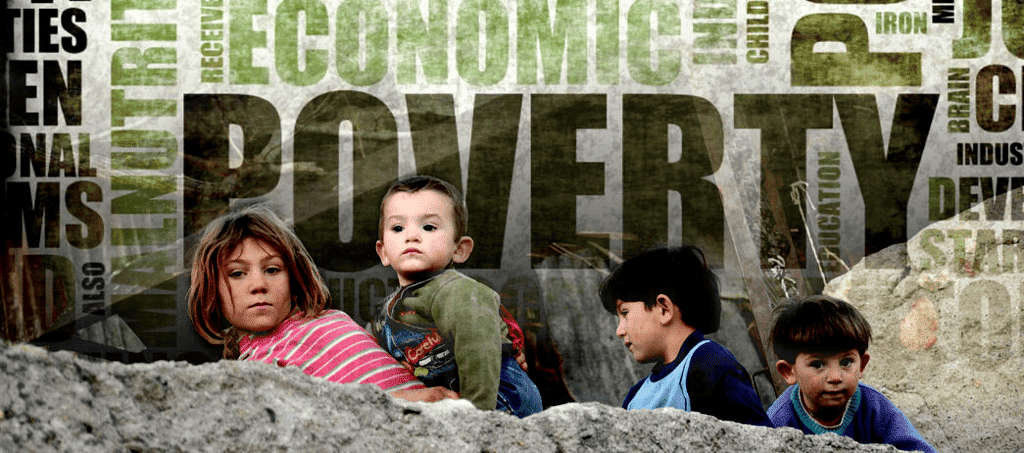
Around 270 million people, or every fifth person, faced this challenge in 2011-12, making India the country with the highest concentration of poor individuals.
It's a serious issue that the government and experts are working to address.
What is Poverty?
Poverty means hunger and lack of shelter. It is also a situation in which parents are not able to send their children to school or a situation where sick people cannot afford treatment.
![]()
- Poverty also means a lack of clean water and sanitation facilities.
- A lack of a regular job at a minimum decent level. Above all, it means living with a sense of helplessness.
- Poor are in a situation in which they are ill-treated at almost every place, including the farms, factories, government offices, hospitals, railway stations, etc.
Two Typical Cases of Poverty
- Poverty refers to the state of deprivation in which an individual or community lacks the necessary resources to maintain a minimum standard of living.
- It is characterized by hunger, lack of shelter, inadequate access to clean water and sanitation facilities, and insufficient employment opportunities.
- Poverty remains one of the most significant challenges faced by independent India, as the nation can only be considered truly independent when its poorest citizens are free from human suffering.
Urban Case
- Ram Saran is a daily wage laborer in a flour mill near Ranchi, Jharkhand, earning around Rs. 1500 per month and supporting a family of 6 people, including sending money to his elderly parents.
 Story of Ram Saran
Story of Ram Saran - His wife and son also work, but their combined income is not enough to afford education for their 4 children, who are unable to attend school.
- The family lives in a one-room rented house on the outskirts of the city, and the children are undernourished, lacking proper clothing, footwear, and access to healthcare.
Rural Case
- Lakha Singh is a landless laborer in a small village near Meerut, Uttar Pradesh, earning Rs. 50 per day by doing odd jobs for farmers, sometimes receiving food grain, or other items instead of cash.
- He is not literate and has a family of 8 people living in a Kuchcha hut at the edge of the village.
- The family has no access to healthcare and cannot afford new clothes, soap, or oil.
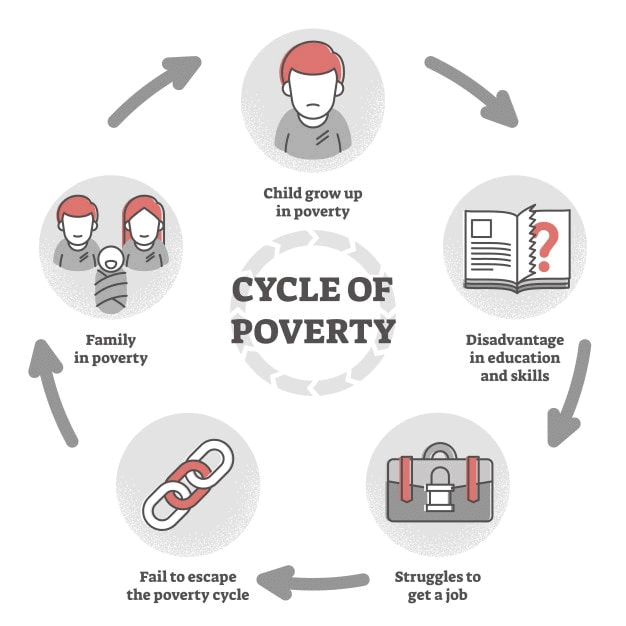 Cycle of Poverty
Cycle of Poverty
Poverty as Seen by Social Scientists
The usual way to measure poverty is by looking at income and spending levels. But now, we also consider other factors like education, health, job opportunities, and access to clean water and sanitation.
Nowadays, we often analyze poverty by focusing on social exclusion and vulnerability.
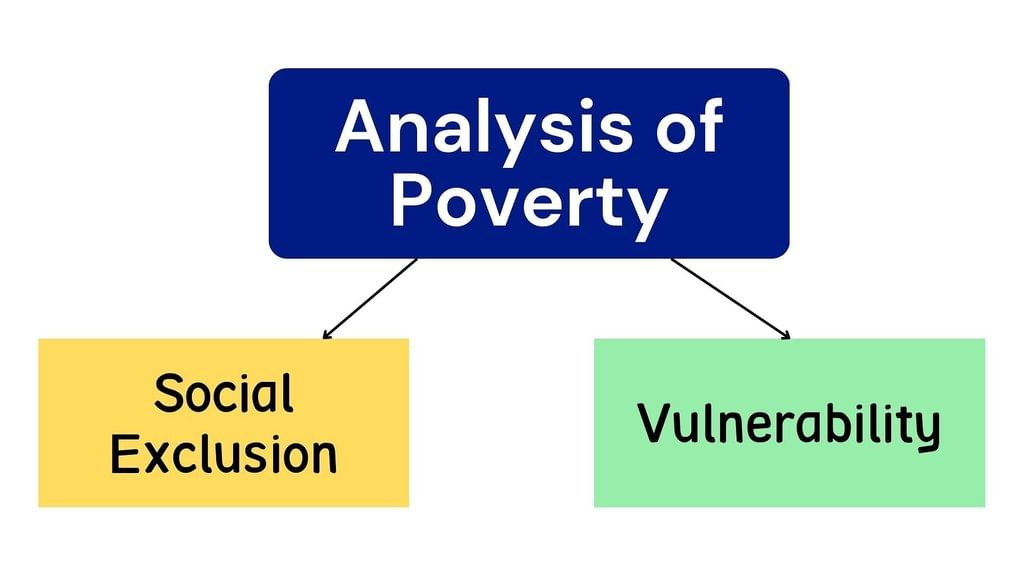 Analysis of Poverty
Analysis of Poverty
Social Exclusion
Poverty is not only about low income but also about being confined to poor surroundings and excluded from the benefits enjoyed by better-off individuals.
- Social exclusion can lead to poverty by limiting access to opportunities and resources.
- It can also result from existing poverty, perpetuating a cycle of disadvantage.
- Individuals or groups are systematically barred from accessing facilities, benefits, and opportunities that others enjoy.
- Example: The caste system in India illustrates social exclusion by denying certain castes equal opportunities and social equality.
- Impact: Social exclusion can cause greater harm than low income alone, as it restricts access to resources and opportunities beyond financial measures.
Vulnerability
Vulnerability describes the greater probability of being more adversely affected than other people when a bad time comes for everybody, whether a flood an earthquake, or simply a fall in the availability of jobs.
Factors Influencing Vulnerability:
- Community and Individual Factors: Members of marginalized communities (e.g., backward castes) or individuals with specific challenges (e.g., widows, physically handicapped) are more vulnerable.
- Options and Resources: Access to assets, education, health care, and job opportunities influences vulnerability.
- Risk Exposure: Greater vulnerability is associated with higher risks from natural disasters (e.g., earthquakes, tsunamis) and other crises.
Poverty Line
- A common method used to measure poverty is based on income or consumption levels. A person is considered poor if his or her income or consumption level falls below a given “minimum level” necessary to fulfill basic needs.
- The poverty line may vary with time and place. Each country uses an imaginary line that is considered appropriate for its existing level of development and its accepted minimum social norms.
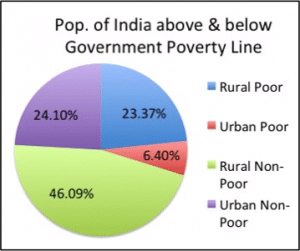 Pop of India above & below Poverty Line
Pop of India above & below Poverty Line
- While determining the poverty line in India, a minimum level of food requirement, clothing, footwear, fuel and light, education, and medical requirement is determined for subsistence. These physical quantities are multiplied by their prices in rupees. The total equivalent is considered the poverty line.
- The daily minimum nutritional requirement for a person has been fixed at 2400 calories per person/ per day in rural areas and 2100 calories per person/ per day in urban areas. The monetary expenditure per capital needed for buying these calorie requirements in terms of food grains etc. is revised periodically, taking into consideration the rise in prices.
- On the basis of these calculations, for the year 2011-12, the poverty line for a person was fixed at Rs. 816 per month in rural areas and Rs. 1000 per month in urban areas. In this way in the year 2011-12, a family of five members living in rural areas and earning less than about Rs. 4080 per month will be below the poverty line. A similar family in the urban areas would need a minimum of Rs. 5000 per month to meet their basic requirements.
- The poverty line is estimated periodically (normally every five years) by conducting sample surveys. These surveys are carried out by the National Sample Survey Organisation (NSSO).
- For making comparisons between developing countries, many international organizations like the World Bank use a uniform standard for the poverty line: minimum availability of the equivalent of $ 1.90 per person per day.
Is the Present Methodology of Poverty Estimation Appropriate?
- No, the present methodology of poverty estimation is not appropriate. It is only a quantitative concept. It captures only a limited part of what poverty really means to the people. It is about a ‘minimum' subsistence level of living rather than a ‘reasonable level of living'.
- Many scholars advocate that we must broaden the concept of human poverty. Other aspects like education, shelter, health, job, self-confidence, equality, etc. should also be included while calculating poverty.
Poverty Estimates

- There is a substantial decline in poverty ratios in India from about 45 percent in 1993-94. The preparation of people below the poverty line further came down to about 37.2 percent in 2004-05.
- If the trend continues, people below the poverty line may come down to less than 20 percent in the next few years. The latest estimates indicated a significant reduction in the number of poor from 407 million in 2004-05 to 270 million in 2011-12.
Vulnerable Groups
- The proportion of people below the poverty line is also not the same for all social groups and economic categories in India.
- Social groups that are most vulnerable to poverty are scheduled caste and scheduled tribe households.
- Among the economic groups, the most vulnerable groups are the rural agricultural labor households and urban casual labor households.
- Although the average for people below the poverty line for all groups in India is 22, 43 out of 100 people belonging to the scheduled tribe are not able to meet their basic needs. Similarly, 34 percent of casual workers in urban areas are below the poverty line. About 34 percent of casual labor farms (rural areas) and 29 percent of scheduled castes are also poor.

- The double disadvantage of being a landless casual wage labor household in the socially disadvantaged social groups of the scheduled caste or the scheduled tribe population highlights the seriousness of the problem.
- Some recent studies have shown that except for the scheduled tribe household, all the other three groups, i.e. scheduled castes, rural agricultural laborers and the urban casual labor household have seen a decline in poverty in the 1990s.
- Women, elderly people, and female infants are systematically denied equal access to resources available to the family. Therefore women, children (especially the girl child) and old people are the poorest of the poor.
Story of Sivaraman
- The family of Sivaraman, a rural landless labourer has been cited as an example of such a family.
- There are 8 members in the family and both he and the wife work. His children do not attend school due to poverty.
- Only his son gets milk sometimes and they find difficulty in managing even two meals in a day.
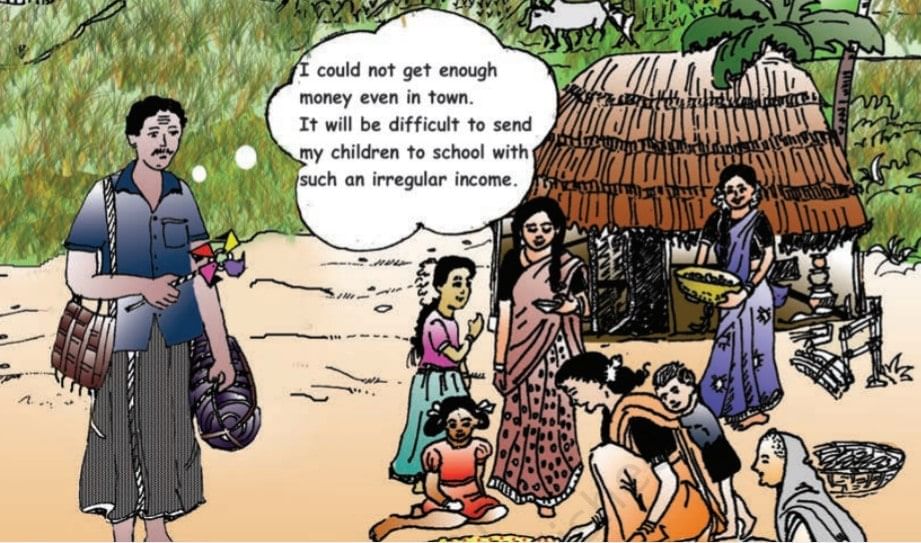 Story of Sivaraman
Story of Sivaraman
- The story portrays the sufferings of Sivaraman who works as an agricultural labourer, that too for just 5-6 months in a year.
- The suffering and inequality within the family for women and children are even more.
- Girls are not sent to school and not even given milk to drink, while the youngest child, who is a son gets milk to drink sometimes and his parents also plan for his education.
Inter-State Disparities
- States with a poverty ratio more than the national average: Orissa, Bihar, Assam, Madhya Pradesh, and Uttar Pradesh are the most poverty-ridden states of India. The poverty ratio in these states is much higher than the national average. Bihar and Orissa are the poorest states with a poverty ratio of 33.7 and 32.6 percent, respectively. Most of these states are facing rural as well as urban poverty.
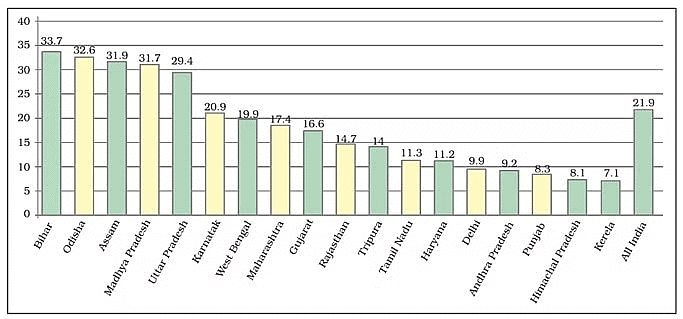 Poverty Ratio in the Selected Indian States- 2011 Census
Poverty Ratio in the Selected Indian States- 2011 Census
- States with a poverty ratio less than the national average: There has been a significant decline in the poverty ratio in Kerala, Maharashtra, Andhra Pradesh, Tamil Nadu, Gujarat, and West Bengal.
- States with low poverty ratio: Punjab and Haryana have low poverty ratios because of high agricultural growth rates. Kerala has focused on human resource development; West Bengal has taken necessary land reform measures to reduce poverty. In states like Andhra Pradesh and Tamil Nadu, the public distribution of food grains has helped in improving the poverty ratio.
Global Poverty Scenario
- The population of people in developing countries living in extreme economic poverty-defined by the World Bank as living on less than $2.15 per day has fallen from 16.67 percent in 2010 to 9.05 percent in 2019. Although there has been a substantial reduction in global poverty, it is marked with great regional differences.
- Poverty declined substantially in China and Southeast Asian countries as a result of rapid economic growth and massive investments in human resource development. The number of poor in China has come down from 2.1 percent in 2014 to 0.1 percent in 2020.
- In the countries of South Asia (India, Pakistan, Sri Lanka, Bangladesh, and Bhutan) the decline has also been rapid from 12.8 percent in 2017 to 10.9 percent in 2021.
- In Sub-Saharan Africa, the poverty ratio declined from 36.6 percent in 2017 to 35.4 percent in 2019.
- In Latin America, the ratio of poverty has also declined from 10 percent in 2005 to 4 percent in 2015.
- Poverty has also resurfaced in some of the former socialist countries like Russia, where officially it was non-existent earlier.
- The new sustainable development goals of the United Nations propose ending poverty of all types by 2030.
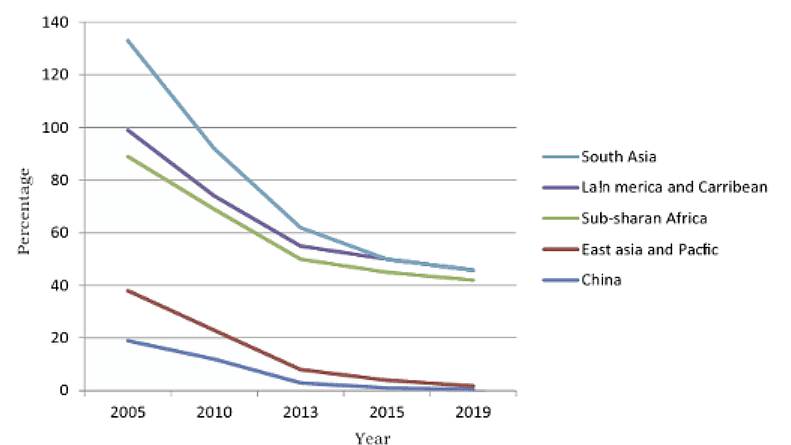 Global Poverty Index
Global Poverty Index
Causes of Poverty
- Colonial Impact: British policies undermined traditional handicrafts and stifled industrial development, resulting in low economic growth and fewer job opportunities.
- Population Growth: High population growth combined with low economic growth led to a low per capita income, perpetuating poverty.
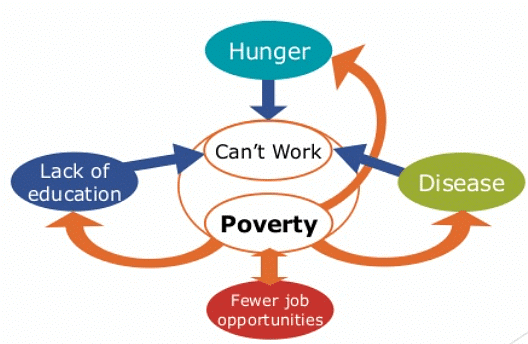
- Irrigation and Green Revolution: Created job opportunities in agriculture but benefits were limited to specific regions.
- Insufficient Job Creation: Limited job opportunities in both public and private sectors led many to work in low-income jobs (e.g., rickshaw pullers, vendors) and live in slums.
- Unequal Resource Distribution: Disparities in land and resource distribution contribute to high poverty rates.
- Ineffective Land Reforms: Poor implementation of land reform policies has failed to address rural poverty effectively.
- Social and Religious Expenses: Poor people often spend on social obligations and ceremonies, exacerbating their financial strain.
- Indebtedness: Small farmers and the poor borrow money for agricultural inputs and other expenses, leading to high levels of debt and further entrenching poverty.
Anti-Poverty Measures
Removing poverty is a top goal for India's development.
The government's strategy centers on two main ideas:
1. Promoting economic growth
2. Targeted anti-poverty programs.
Economic Growth
- Before the 1980s, not much progress was made, but since then, India's rapid economic growth has significantly reduced poverty.
- Economic growth, reaching about 6 percent annually, creates opportunities and resources for human development.
- It encourages people, including girls, to pursue education for better economic prospects.
Need for Targeted Programs
- Given the challenges, there's a clear need for specific anti-poverty programs.
- The Mahatma Gandhi National Rural Employment Guarantee Act (MGNREGA) guarantees 100 days of employment to households in rural areas.
- The program, active since 2005, focuses on sustainable development and has reserved jobs for women, providing significant employment.
Targeted Anti-poverty programs
1. Mahatma Gandhi National Rural Employment Guarantee Act, 2005

- It was passed in September 2005. This Act provides for 100 days of assured employment every year to every rural household in 200 districts. Later the scheme was extended to 600 districts.
- One-third of the proposed jobs have been reserved for women.
- The Central Government established National Employment Guarantee Funds.
- The state government established State Employment Guarantee Funds for the implementation of the scheme.
- Under the program, if an applicant is not provided employment within fifteen days, she/he will be entitled to a daily unemployment allowance.
- The scheme provided employment to 220 crore person-days of employment to 4.78 crore households.
- After the revised wage rates in March 2018, the range of wage rate lies in between Rs 281 per day(for the workers in Haryana) to Rs 168 per day(for the workers of Bihar and Jharkhand).
2. National Food for Work Programme (NFWP)
- It was launched in 2004 in the 150 most backward districts of the country.
- The program is open to all rural poor who are in need of wage employment and desire to do manual unskilled work.
- It is implemented as a 100 percent centrally sponsored scheme and food grains are provided free of cost to the states.
3. Prime Minister Rozgar Yozana (PMRY)
- It is another scheme which was started in 1993.
- The aim of the program is to create self-employment opportunities for educated unemployed youth in rural areas and small businesses and industries.
- They are helped in setting up small businesses and industries.
4. Rural Employment Generation Programme (REGP)
- It was launched in 1995.
- The aim of the program is to create self-employment opportunities in rural areas and small towns.
- A target for creating 25 lakh new jobs has been set for the program under the Tenth Five Year Plan.
5. Swarnajayanti Gram Swarozgar Yojana (SGSY)
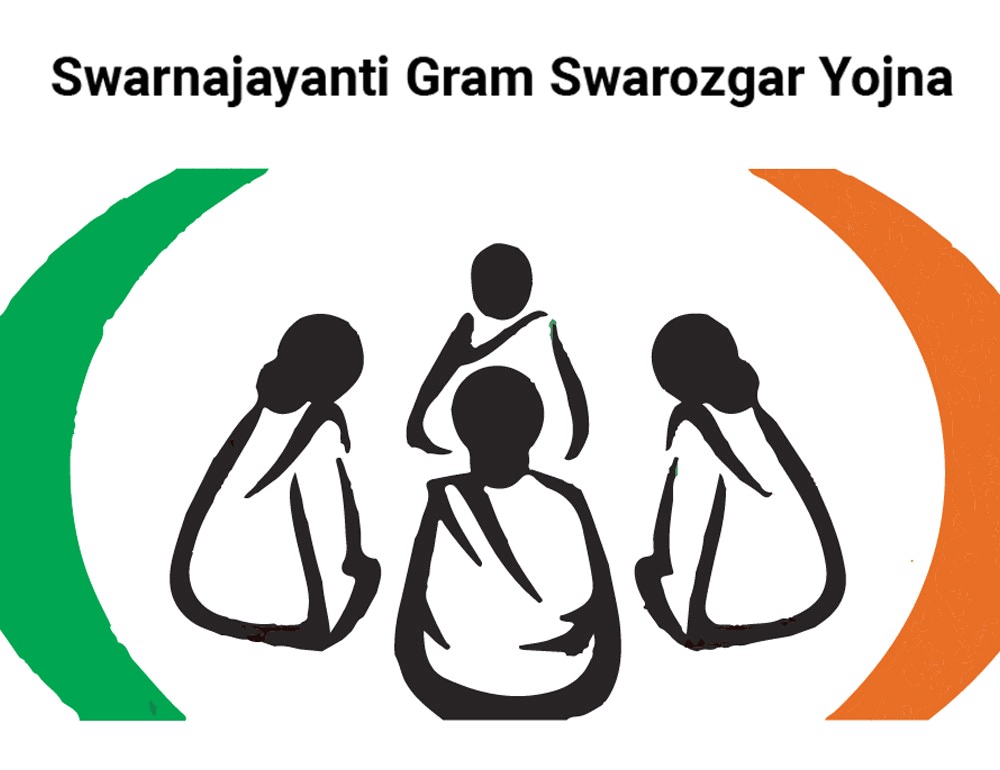
- It was launched in 1999.
- The program aims at bringing the assisted poor families above the poverty line by organizing them into self-help groups through a mix of bank credit and government subsidy.
6. Pradhan Mantri Gramodaya Yozana (PMGY)
- It was launched in 2000.
- Additional central assistance is given to states for basic services such as primary health, primary education, rural shelter, rural drinking water, and rural electrification.
7. Antyodaya Anna Yozana (AAY)
- This scheme was launched in December 2000. Under this scheme, one crore of the poorest among the BPL families covered under the targeted public distribution system was identified.
- Poor families were identified by the respective state rural development departments through a Below Poverty Line (BPL) survey. Twenty-five kilograms of food grains were made available to each eligible family at a highly subsidized rate of Rs. 2 per Kg for wheat and Rs. 3 per for rice. This quantity has been enhanced from 25 to 35 kg with effect from April 2002.
- The scheme has been further expanded twice by an additional 50 lakh BPL families in June 2003 and in August 2004. With this increase, 2 crore families have been covered under the AAY.
Challenges in Implementation
- While these programs have good intentions, their effectiveness varies due to improper implementation and targeting.
- Overlapping schemes and a lack of proper monitoring contribute to limited benefits reaching deserving individuals.
- Recent efforts emphasize proper monitoring to ensure the success of poverty alleviation programs.
The Challenges Ahead
- Poverty has certainly declined in India. But despite the progress, poverty reduction remains India’s most compelling challenge. Wide disparities in poverty are visible between rural and urban areas and among different states.
- Poverty reduction is expected to make better progress in the next ten to fifteen years. This would be possible mainly due to higher economic growth, increasing stress on universal free elementary education, declining population growth, and increasing empowerment of women and the economically weaker section of society.
- The official definition of poverty captures only a limited part of what poverty really means to people. It is about a “minimum” subsistence level of living rather than a “reasonable” level of living. We must broaden the concept into human poverty.
- With development, the definition of what constitutes poverty also changes. Eradication of poverty is always a moving target. Hopefully, we will be able to provide the minimum “necessary” in terms of income to all people by the end of the next decade. But the target will move on for all and achieve gender equality and dignity for the poor. These will be even bigger tasks.
Difficult Words
- Social Exclusion: This refers to the process by which certain individuals or groups are systematically blocked from rights, opportunities, and resources that are normally available to members of society and that are key to social integration. This exclusion can happen in various areas such as employment, healthcare, education, and civic engagement.
Vulnerability: In the context of poverty, vulnerability refers to the increased likelihood of certain populations to fall into poverty or to be adversely affected by economic crises or natural disasters due to a lack of adequate social, economic, and environmental protections.
Poverty Line: A monetary threshold used to differentiate between those who are considered poor and those who are not, based on their income or consumption levels. This benchmark helps to measure the extent of poverty within a country.
Subsistence Level: The minimum level of resources necessary for physical well-being, typically including food, water, and shelter. In poverty measurements, subsistence refers to the absolute basics needed to maintain life.
Disguised Unemployment: Occurs when more people are working in a job than is necessary for its fulfillment. For example, if three people are doing a job that two people could accomplish, the third person is considered disguisedly unemployed because their work does not contribute to increased output.
Underemployment: This involves individuals working less than they would like or in jobs that do not utilize their skills and educational qualifications. It represents a wastage of human resources.
Scheduled Castes and Scheduled Tribes: These are specific categories of historically disadvantaged groups in India that are identified in the Constitution of India. Members of these groups face higher levels of poverty and social exclusion.
Universal Adult Franchise: Also known as universal suffrage, this is the right of all adult citizens to vote in elections without restrictions due to race, sex, belief, wealth, or social status.
National Food for Work Programme (NFWP): An initiative aimed at alleviating poverty by providing food in exchange for work. This program targets the most backward districts of the country to enhance food security while creating employment.
Mahatma Gandhi National Rural Employment Guarantee Act (MGNREGA): A landmark labor law in India that aims to guarantee the 'right to work' by providing at least 100 days of wage employment in a financial year to every rural household whose adult members volunteer to do unskilled manual work.
Below Poverty Line (BPL): A governmental classification in India to identify families that are economically weaker and in need of government assistance and aid. Families under this line receive benefits from various government schemes.
Pradhan Mantri Gramodaya Yozana (PMGY): A comprehensive scheme aimed at improving the availability and quality of critical services like healthcare, education, and rural shelter through additional central assistance to states.
Antyodaya Anna Yozana (AAY): A government scheme aimed at reducing chronic hunger and malnutrition by providing highly subsidized food to the poorest segments of society.
|
53 videos|437 docs|80 tests
|
FAQs on Class 9 Economics Chapter 3 Notes - Poverty as a Challenge
| 1. What is the poverty line and how is it determined? |  |
| 2. What are some of the vulnerable groups that are most affected by poverty? |  |
| 3. What are some of the main causes of poverty according to social scientists? |  |
| 4. How do anti-poverty measures help in addressing the challenges of poverty? |  |
| 5. How do global poverty estimates compare to inter-state disparities in India? |  |

|
Explore Courses for Class 9 exam
|

|
